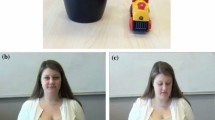Abstract
Describing the location of a landmark in ascene typically requires taking a perspective. Descriptions of scenes with several landmarksuse either a route perspective, where theviewpoint is within the scene or a surveyperspective, where the viewpoint is outside, ora mixture of both. Parallel to this, AmericanSign Language (ASL) uses two spatial formats,viewer space, in which the described space isconceived of as in front of the speaker, ordiagrammatic space, in which the describedspace is conceived of as from outside, usuallyabove. In the present study, speakers ofEnglish or ASL described one of two memorizedmaps. ASL signers were more likely to adopt asurvey perspective than English speakers,indicating that language modality can influenceperspective choice. In ASL, descriptions froma survey perspective used diagrammatic space,whereas descriptions from a route perspectiveused viewer space. In English, iconic gesturesaccompanying route descriptions used the full3-D space, similar to viewer space, whilegestures accompanying survey descriptions useda 2-D horizontal or vertical plane similar todiagrammatic space. Thus, the two modes ofexperiencing environments, from within and fromwithout, are expressed naturally in speech,sign, and gesture.
Similar content being viewed by others
References
Bellugi, U. and Fischer, S. (1972). A Comparison of Sign Language and Spoken Language, Cognition 1: 173–200.
Bryant, D.J. and Tversky, B. (1999). Mental Representations of Spatial Relations from Diagrams and Models, Journal of Experimental Psychology: Learning, Memory and Cognition 25: 137–156.
Bryant, D.J., Tversky, B. and Franklin, N. (1992). Internal and External Spatial Frameworks for Representing Described Scenes, Journal of Memory and Language 31: 74–98.
Ehrich, V. and Koster, C. (1983). Discourse Organization and Sentence Form: The Structure of Foom Descriptions in Dutch. Discourse Processes 6: 169–195.
Emmorey, K. (1996). The Confluence of Space and Language in Signed Languages. In P. Bloom, M. Peterson, L. Nadel and M. Garrett (eds.), Language and Space (pp. 171–209). Cambridge, MA: MIT Press.
Emmorey, K. (in press). Language, Cognition, and the Brain: Insights from Sign Language Research. Mahwah, NJ: Lawrence Erlbaum Associates.
Emmorey, K. (1999). Do Signers Gesture? In L. Messing and R. Campbell (eds.), Gesture, Speech, and Sign. New York: Oxford University Press.
Emmorey, K. and Falgier, B. (1999). Talking about Space with Space: Describing Environments in ASL. In E.A. Winston (ed.), Story Telling and Conversations: Discourse in Deaf Communities (pp. 3–26). Washington, D.C.: Gallaudet University Press.
Engle, R.A. (1998). Constructing Spatially-Anchored Models with Multimodal Explanations. Poster presented at the 106th Meetings of the American Psychological Association, San Francisco, CA.
Franklin, N., Tversky, B. and Coon, V. (1992). Switching Points of View in Spatial Mental Models Acquired from Text, Memory and Cognition 20: 507–518.
Franklin, N. and Tversky, B. (1990). Searching Imagined Environments, Journal of Experimental Psychology: General 119: 63–76.
Iverson, J. and Goldin-Meadow, S. (1998). Why People Gesture When They Speak, Nature 396(6709): 228.
Levelt, W. (1982). Linearization in Describing Spatial Networks. In S. Peters and E. Saarinen (eds.), Processes, Beliefs, and Questions (pp. 199–220). Reidel Publishing Company.
Levinson, S. (1996). Frames of Reference and Molyneux's Question: Crosslinguistic Evidence. In P. Bloom, M. Peterson, L. Nadel and M. Garrett (eds.), Language and Space (pp. 109–170). Cambridge, MA: MIT Press.
Lucas, C. and Valli, C. (1990). Predicates of Perceived Motion in ASL. In S.D. Fischer and P. Siple (eds.), Theoretical Issues in Sign Language Research, Volume 1: Linguistics (pp. 153–166). The University of Chicago Press: Chicago, IL.
McNeill, D. (1992). Hand and Mind: What Gestures Reveal about Thought. The University of Chicago Press.
Perrig, W. and Kintsch, W. (1985). Propositional and Situational Representations of Text. Journal of Memory and Language 24: 503–518.
Scholl, M.J. and Egeth, H.E. (1981). Right-Left Confusion in the Adult: A Verbal Labeling Effect, Memory and Cognition 9: 339–350.
Supalla, T. (1986). The Classifier System in American Sign Language. In C. Craig (ed.), Noun Classification and Categorization. Amsterdam: John Benjamins North America.
Taylor, H.A. and Tversky, B. (1992a). Descriptions and Depictions of Environments, Memory and Cognition 20: 483–496.
Taylor H.A. and Tversky, B. (1992b). Spatial Mental Models Derived from Survey and Route Descriptions, Journal of Memory and Language 31: 261–292.
Taylor, H.A. and Tversky, B. (1996). Perspective in Spatial Descriptions, Journal of Memory and Language 35(3): 371–391.
Tversky, B. (1981). Distortions in Memory for Maps, Cognitive Psychology 13: 407–433.
Tversky, B. (1996). Spatial Perspective in Descriptions. In P. Bloom, M.A. Peterson, L. Nadel and M.F. Garrett (eds.), Language and Space (pp. 463–492). Cambridge, MA: MIT Press.
Tversky, B. (2000). How Space Structures Language. In C. Freksa, C. Brauer, W., Habel and K.F. Wender (eds.), Spatial Cognition II: Integrating Abstract theories, Empirical Studies, Formal Models, and Practical Applications (pp. 72–79). Berlin: Springer.
Valli, C. and Lucas, C. (1995). Linguistics of American Sign Language: An introduction, 2nd edn. Washington, DC: Gallaudet University Press.
Author information
Authors and Affiliations
Rights and permissions
About this article
Cite this article
Emmorey, K., Tversky, B. & Taylor, H.A. Using space to describe space: Perspective in speech, sign, and gesture. Spatial Cognition and Computation 2, 157–180 (2000). https://doi.org/10.1023/A:1013118114571
Issue Date:
DOI: https://doi.org/10.1023/A:1013118114571




